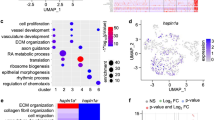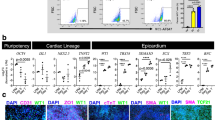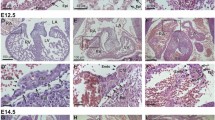Abstract
Heart septation and valve malformations constitute the most common anatomical birth defects. These structures arise from the endocardial cushions within the atrioventricular canal (AVC) through dynamic interactions between cushion cells and the extracellular matrix (termed cardiac jelly). Transformation of endothelial cells to mesenchymal cells is essential for the proper development of the AVC and subsequent septation and valve formation. Atrioventricular septal defects can result from incomplete endocardial cushion morphogenesis. We show that hyaluronan-deficient AVC explants from Has2−/− embryos, which normally lack mesenchyme formation, are rescued by heregulin treatment, which restores phosphorylation of ErbB2 and ErbB3. These events were blocked using a soluble ErbB3 molecule, as well as with an inhibitor of ErbB2, herstatin. We show further that ErbB3 is activated during hyaluronan treatment of Has2−/− explants. These data provide a link between extracellular matrix-hyaluronan and ErbB receptor activation during development of early heart-valve and septal mesenchyme.
This is a preview of subscription content, access via your institution
Access options
Subscribe to this journal
Receive 12 print issues and online access
$209.00 per year
only $17.42 per issue
Buy this article
- Purchase on Springer Link
- Instant access to full article PDF
Prices may be subject to local taxes which are calculated during checkout






Similar content being viewed by others
References
Ferencz, C. & Boughman, J.A. Congenital heart disease in adolescents and adults. Teratology, genetics, and recurrence risks. Cardiol. Clinics 11, 557–567 (1993).
Srivastava, D. Genetic assembly of the heart: implications for congenital heart disease. Annu. Rev. Physiol. 63, 451–469 (2001).
Eisenberg, L.M. & Markwald, R.R. Molecular regulation of atrioventricular valvuloseptal morphogenesis. Circ. Res. 77, 1–6 (1995).
Camenisch, T.D. et al. Disruption of hyaluronan synthase-2 abrogates normal cardiac morphogenesis and hyaluronan-mediated transformation of epithelium to mesenchyme. J. Clin. Invest. 106, 349–360 (2000).
Walsh, E.C. & Stainier, D.Y. UDP-glucose dehydrogenase required for cardiac valve formation in zebrafish. Science 293, 1670–1673 (2001).
Meyer, D. & Birchmeier, C. Multiple essential functions of neuregulin in development. Nature 378, 386–390 (1995); erratum: 378, 753 (1995).
Gassmann, M. et al. Aberrant neural and cardiac development in mice lacking the ErbB4 neuregulin receptor. Nature 378, 390–394 (1995).
Lee, K.F. et al. Requirement for neuregulin receptor ErbB2 in neural and cardiac development. Nature 378, 394–398 (1995).
Erickson, S.L. et al. ErbB3 is required for normal cerebellar and cardiac development: a comparison with ErbB2-and heregulin-deficient mice. Development 124, 4999–5011 (1997).
Hertig, C.M., Kubalak, S.W., Wang, Y. & Chien, K.R. Synergistic roles of neuregulin-1 and insulin-like growth factor-I in activation of the phosphatidylinositol 3-kinase pathway and cardiac chamber morphogenesis. J. Biol. Chem. 274, 37362–37369 (1999).
Riethmacher, D. et al. Severe neuropathies in mice with targeted mutations in the ErbB3 receptor. Nature 389, 725–730 (1997).
Bourguignon, L.Y. et al. Interaction between the adhesion receptor, CD44, and the oncogene product, p185HER2, promotes human ovarian tumor cell activation. J. Biol. Chem. 272, 27913–27918 (1997).
Park, P.W., Reizes, O. & Bernfield, M. Cell surface heparan sulfate proteoglycans: Selective regulators of ligand-receptor encounters. J. Biol. Chem. 275, 29923–29926 (2000).
Baldwin, H.S. Early embryonic vascular development. Cardiovasc. Res. 31, E34–45 (1996).
Runyan, R.B. & Markwald, R.R. Invasion of mesenchyme into three-dimensional collagen gels: a regional and temporal analysis of interaction in embryonic heart tissue. Dev. Biol. 95, 108–114 (1983).
Camenisch, T.D., Biesterfeldt, J., Brehm-Gibson, T., Bradley, J. & McDonald, J.A. Regulation of cardiac cushion development by hyaluronan. Exp. Clin. Cardiol. 6, 4–10 (2001).
Olayioye, M.A., Neve, R.M., Lane, H.A. & Hynes, N.E. The ErbB signaling network: receptor heterodimerization in development and cancer. EMBO J. 19, 3159–3167 (2000).
Yarden, Y. & Sliwkowski, M.X. Untangling the ErbB signalling network. Nature Rev. Mol. Cell Biol. 2, 127–137 (2001).
Doherty, J.K., Bond, C., Jardim, A., Adelman, J.P. & Clinton, G.M. The HER-2/neu receptor tyrosine kinase gene encodes a secreted autoinhibitor. Proc. Natl. Acad. Sci. USA 96, 10869–10874 (1999).
Lee, H., Akita, R.W., Sliwkowski, M.X. & Maihle, N.J. A naturally occurring secreted human ErbB3 receptor isoform inhibits heregulin-stimulated activation of ErbB2, ErbB3, and ErbB4. Cancer Res. 61, 4467–4473 (2001).
Chen, B. et al. Mice mutant for Egfr and Shp2 have defective cardiac semilunar valvulogenesis. Nature Genet. 24, 296–299 (2000).
Aruffo, A., Stamenkovic, I., Melnick, M., Underhill, C.B. & Seed, B. CD44 is the principal cell-surface receptor for hyaluronate. Cell 61, 1303–1313 (1990).
Sherman, L., Sleeman, J., Herrlich, P. & Ponta, H. Hyaluronate receptors: key players in growth, differentiation, migration and tumor progression. Cur. Opin. Cell Biol. 6, 726–733 (1994).
Schmits, R. et al. CD44 regulates hematopoietic progenitor distribution, granuloma formation, and tumorigenicity. Blood 90, 2217–2233 (1997).
Serbulea, M. et al. Hyaluronan activates mitogen-activated protein kinase via Ras-signaling pathway. Inter. J. Oncol. 14, 733–738 (1999).
Fitzgerald, K.A., Bowie, A.G., Skeffington, B.S. & O'Neill, L.A. Ras, protein kinase C zeta, and I κB kinases 1 and 2 are downstream effectors of CD44 during the activation of NF-κB by hyaluronic acid fragments in T-24 carcinoma cells. J. Immunol. 164, 2053–2063 (2000).
Lakkis, M.M. & Epstein, J.A. Neurofibromin modulation of ras activity is required for normal endocardial-mesenchymal transformation in the developing heart. Development 125, 4359–4367 (1998).
Anderson, R.H., Webb, S. & Brown, N.A. The mouse with trisomy 16 as a model of human hearts with common atrioventricular junction. Cardiovasc. Res. 39, 155–164 (1998).
Webb, S., Brown, N.A. & Anderson, R.H. Formation of the atrioventricular septal structures in the normal mouse. Circ. Res. 82, 645–656 (1998).
Rubin, J.D. et al. Congenital cardiovascular malformations in the Baltimore-Washington area. Md. Med. J. 34, 1079–1083 (1985).
Markwald, R., Eisenberg, C., Eisenberg, L., Trusk, T. & Sugi, Y. Epithelial-mesenchymal transformations in early avian heart development. Acta Anatomica 156, 173–186 (1996).
Pinkas-Kramarski, R. et al. Diversification of Neu differentiation factor and epidermal growth factor signaling by combinatorial receptor interactions. EMBO J. 15, 2452–2467. abs.html (1996).
Pinkas-Kramarski, R., Shelly, M., Glathe, S., Ratzkin, B.J. & Yarden, Y. Neu differentiation factor/neuregulin isoforms activate distinct receptor combinations. J. Biol. Chem. 271, 19029–19032 (1996).
O'Shea, S., Johnson, K., Clark, R., Sliwkowski, M.X. & Erickson, S.L. Effects of in vivo heregulin beta1 treatment in wild-type and ErbB gene- targeted mice depend on receptor levels and pregnancy. Am. J. Pathol. 158, 1871–1880 (2001).
Acknowledgements
We thank S. Erickson for the ErbB2- and ErbB3-targeted mouse lines; G. Lemke for the ErbB4-targeted mouse line; C. Birchmeier for the Heregulin-targeted mouse line; G. Clinton for the Herstatin plasmid19; N. Maihle and H. Lee for purified soluble p85 ErbB3 protein20; D. Lee and N. Luetteke for critical discussions; A.N. Camenisch for inspirational discussions; M. Ruona for medical graphics support; and C. Williams and S. Fleck for manuscript preparation. This study was supported by the PANDA Foundation.
Author information
Authors and Affiliations
Corresponding author
Ethics declarations
Competing interests
The authors declare no competing financial interests.
Supplementary information
Rights and permissions
About this article
Cite this article
Camenisch, T., Schroeder, J., Bradley, J. et al. Heart-valve mesenchyme formation is dependent on hyaluronan-augmented activation of ErbB2–ErbB3 receptors. Nat Med 8, 850–855 (2002). https://doi.org/10.1038/nm742
Received:
Accepted:
Published:
Issue Date:
DOI: https://doi.org/10.1038/nm742
This article is cited by
-
Lymphatic trafficking of immune cells and insights for cancer metastasis
Clinical & Experimental Metastasis (2023)
-
Caudal duplication syndrome: a literature review and reappraisal of its pathoembryogenesis
Child's Nervous System (2021)
-
Single cell sequencing reveals endothelial plasticity with transient mesenchymal activation after myocardial infarction
Nature Communications (2021)
-
Dose- and time-dependent effects of hyaluronidase on structural cells and the extracellular matrix of the skin
European Journal of Medical Research (2020)
-
Dysregulation of Hyaluronan Homeostasis During White Matter Injury
Neurochemical Research (2020)



